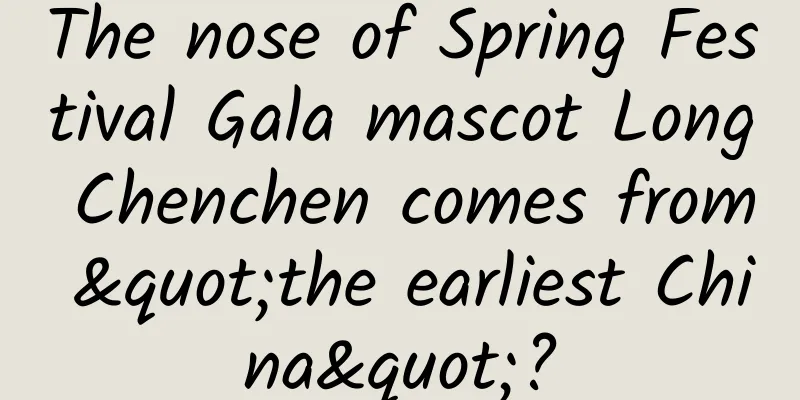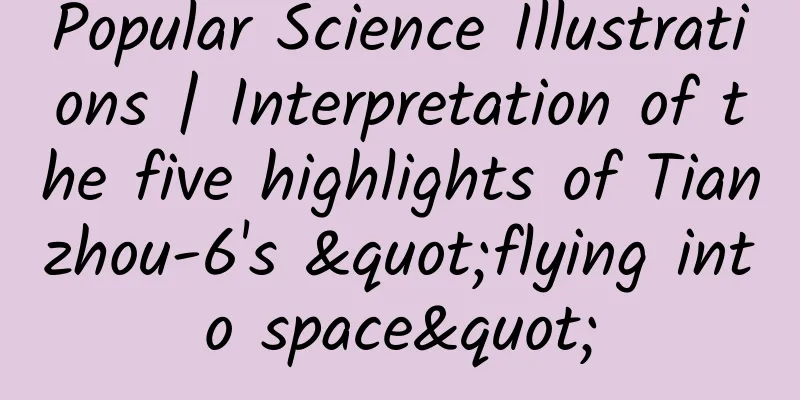The nose of Spring Festival Gala mascot Long Chenchen comes from "the earliest China"?

|
Last December, the CCTV 2024 Spring Festival Gala mascot "Long Chenchen" was officially released. As an important spiritual symbol and cultural symbol of the Chinese nation, the dragon carries the beautiful meaning of good luck, peace and happiness. The inspiration for the nose of the mascot "Long Chenchen" comes from the representative object of the dragon totem of the Chinese nation- the turquoise dragon-shaped vessel unearthed from the Erlitou site in Yanshi County, Henan Province. Many scholars believe that this turquoise dragon has found the most direct and orthodox root of the dragon totem of the Chinese nation and is the real "China's first dragon" . The 2024 Spring Festival Gala live broadcast is imminent, let's take a look at the "China's first dragon" on the nose of the Spring Festival Gala mascot Long Chenchen. Long Chenchen, the mascot of the 2024 CCTV Spring Festival Gala (Source: CCTV News) 01 The inspiration for Long Chenchen’s nose: “China’s First Dragon” from the Erlitou Site The Erlitou site is located in the eastern part of the Luoyang Basin. Since its discovery in 1959, it has unearthed extremely rich cultural relics. After more than half a century of archaeological research, it has been shown that the Erlitou site is the earliest capital of a large-scale monarchy in the Luoyang Basin, so it is known as the "earliest China" . At present, in the Chinese archaeological community, it is generally believed that the Erlitou site is the capital site of the late Xia Dynasty. Aerial photography of Erlitou Archaeological Site Park (Source: Visual China) This turquoise dragon-shaped vessel was found in a noble tomb of the early Erlitou culture in the Erlitou palace area. It is one of the highest-level tombs in the Erlitou capital city known so far . The tomb owner is an adult male, aged between 30 and 35 years old. The burial objects in the tomb include bronze bells, jade bell tongues, bird-head jade ornaments, perforated turquoise beads, and white pottery in the shape of a bamboo hat. The turquoise dragon-shaped vessel was placed on the skeleton of the tomb owner, from the shoulder to the hip bone, and it is speculated that it was placed diagonally on the right arm of the tomb owner. Turquoise dragon-shaped vessel unearthed from the Erlitou site (Source: Visual China) The turquoise dragon is majestic, with a giant head and a curled tail. Its body is curved and colorful. The dragon is about 65 cm long and 4 cm wide at the middle. It is inlaid with more than 2,000 turquoise pieces of various shapes . Each piece of turquoise is only 0.2-0.9 cm in size and only about 0.1 cm thick. These turquoises should have been attached to organic materials such as wood or leather, but the organic materials they were attached to have long since decayed, leaving only white gray marks in some parts. Close-up of a turquoise dragon-shaped vessel unearthed from the Erlitou site (Source: Visual China) The dragon head is oblate and cleverly placed on a nearly trapezoidal bracket made of turquoise pieces. The surface of the bracket is made of turquoise pieces to form a layered pattern, with many curled arcs extending from the dragon head, as if showing the image of dragon whiskers or temples. Two rows of turquoise are glued on the outer edge of the bracket. The dragon head is slightly raised compared to the bracket, slightly in bas-relief, and is an oblate giant head with a slightly raised snout. The forehead ridge and nose bridge are composed of three solid semicircular green and white jade columns. The turquoise garlic-shaped nose tip is huge and eye-catching , which is also the source of inspiration for the nose of the Spring Festival Gala mascot "Long Chenchen". The roots of the jade columns and the nose tip are carved with parallel convex string patterns and shallow grooves. The arcs on both sides outline the symmetrical eye sockets, which are shuttle-shaped eyes with dynamic contour lines. Turquoise pieces are also embedded in the eye sockets, and the round cake-shaped white jade protruding from the top surface forms a unique eye. Long Chenchen's nose was inspired by a turquoise dragon-shaped object (Source: CCTV News) The dragon's body is slightly wavy, with a ridgeline in the middle that slopes downward to both sides. A row of turquoise pieces are glued to the outer edge. The main rhombus pattern composed of turquoise pieces symbolizes scales and is continuously distributed throughout the body, with at least 12 units from the neck to the tail. The part near the tail gradually becomes an arc, presenting a more realistic effect, and the tail tip is curved inside, making it lifelike. 3.6 cm away from the end of the turquoise dragon's tail, there is a turquoise strip ornament that is almost perpendicular to the dragon's body. There are red paint marks between the two, and they should have been integrated with the organic object attached to the dragon's body. The upper part is composed of a row of horizontal rectangular turquoise pieces and a row of vertical rectangular turquoise pieces in parallel, while the lower part shows a continuous pattern similar to hook cloud patterns, and a piece of turquoise at the west end also has several convex string patterns. The turquoise dragon-shaped vessel is another important discovery of early Chinese dragon-shaped cultural relics and turquoise-inlaid cultural relics. Its huge labor, fine craftsmanship and large size are very rare among early Chinese dragon-shaped cultural relics, and it has extremely high historical, artistic and scientific value. 02 Erlitou’s “Signature”: Turquoise Processing Technology In addition to this turquoise dragon-shaped vessel, the Erlitou site also unearthed a number of turquoise dragon plaques . These exquisite ornaments are closely related to the prosperous turquoise processing technology during the Erlitou period. Shortly after the discovery of the turquoise dragon-shaped vessel, the Erlitou site revealed a large-scale turquoise handicraft workshop, unearthed a large number of raw materials, blanks, semi-finished products, finished products, and production tools, providing important physical evidence for our analysis of the production of turquoise vessels. A bronze plaque with animal-face patterns inlaid with turquoise unearthed from the Erlitou site (Source: Visual China) Through the study of the craftsmanship of Erlitou turquoise artifacts, archaeologists found that the production process of Erlitou turquoise artifacts includes multiple technical links, such as raw stone mining, cutting, grinding, perforation, polishing, inlaying and splicing , forming a complex process and diverse processing methods. Modern turquoise processing technology is inextricably linked to the production links of the Erlitou period, vividly demonstrating the long history and ever-evolving vitality of Chinese civilization. In the Erlitou era, turquoise objects, like jade objects, were high-end consumer goods for the aristocracy. The existence of a turquoise object production workshop shows that the ancestors of Erlitou had established a stable turquoise supply system at that time. There may be many sources of raw materials for the turquoise products unearthed from the Erlitou site. Combining a variety of scientific and technological analysis methods, archaeologists can currently determine that the turquoise mining site at the mouth of the Luo River in Luonan County, Shaanxi Province and the Yungai Temple turquoise mine in the northern mining belt of the Hubei, Henan and Shaanxi turquoise mines are both important sources of raw materials for the turquoise unearthed from the Erlitou site. 03 The Dragon Totem of the Xia People The turquoise dragon-shaped vessel is the earliest known "dragon" relic in the Erlitou culture, and it is also the most vivid "dragon" relic. Its origin may be inherited from the Shimao culture in the Hetao area. The turquoise dragon-shaped vessel at the Erlitou site is similar to the stone dragon pattern found at the Shimao site, both of which highlight the head, long body and curled tail, arc-shaped shield-shaped large head, spindle-shaped eyes, arc-convex snout, slender nose, slender body with scale-like patterns, and arc-shaped tail upturned. The image of a dragon carved in stone at the Shimao site (Source: Screenshot from the paper [1]) The turquoise dragon-shaped vessel is a ritual vessel , reflecting the Xia people's respect for dragons . It is also confirmed by the records of Xia Yu, Xia Qi, and Kong Jia "riding dragons" in historical documents. There are records of Xia people raising and training dragons in "Zuo Zhuan", and there are similar records in "Shiji". The Xia people had officials who respected and raised dragons. Gun, Yu, and Qi, the founders of the Xia Dynasty, all had close relationships with dragons. The dragon was closely related to the rise and fall of the Xia royal family and occupied an important position in the Xia people's ritual system. The Erlitou site should be the capital of the Xia Dynasty. It is credible that the dragon is the totem of the Xia nation. The dragon is an important symbol of the formation of the Xia Dynasty state. It proves the Xia people's beliefs in a unique way . 04 The Dawn of Civilization, the Earliest China The turquoise dragon-shaped vessel appeared in the palace area during the early period of the rise of the Erlitou capital. During this period, the Erlitou settlement had already shown the dawn of a shining civilization. At a press conference held by the State Administration of Cultural Heritage not long ago, the Chinese Civilization Origin Project announced its latest research results, clearly stating that since about 5,800 years ago, social differentiation has occurred in various regions of China, entering an accelerated stage of the origin of civilization. Taking the period from 5,800 years ago to 3,800 years ago as an important time node, the origin process of Chinese civilization is divided into two periods: the ancient country era and the dynasty era. The Erlitou site and Sanxingdui site that survived in the latter period have become the focus of today's archaeological research. Restoration model of the palace building of the Xia Dynasty capital at Erlitou site (Source: Visual China) After more than 60 years of archaeological discoveries and research, the Erlitou site has discovered many "China's bests", including the earliest urban main road network, earlier wheel tracks (earlier ones were found in Pingliangtai), the "earliest Forbidden City", the earliest bronze casting workshop, the earliest large-scale state-run workshop, etc. It is a key support for the Chinese Civilization Origins Exploration Project and Xia Culture Research, and also provides important support for the public to understand China's 5,000-year civilization and enhance cultural confidence. References: [1] “The remains of the large platform of the Imperial City at the Shimao site in Shenmu City, Shaanxi Province”, Archaeology, No. 7, 2020. Author: Liu Yunsong, PhD in Archaeology, Wuhan University Reviewer: Zhao Haitao, Associate Researcher, Institute of Archaeology, Chinese Academy of Social Sciences, Leader of the Erlitou Working Group Produced by: Science Popularization China Produced by: China Science and Technology Press Co., Ltd., China Science and Technology Publishing House (Beijing) Digital Media Co., Ltd. |
<<: Speaking of "dragon" in the Year of the Dragon, do you know the rumors behind these "dragons"?
>>: Major breakthrough! Musk announces first human brain chip implant
Recommend
Can Momo, who has a godfather, really make a comeback?
Momo is finally going public. This time, Momo not...
The essence of brand operation, using F4 to crack Steve Jobs' reality distortion
Today we are going to talk to you about how brand...
The 2021 Douyin account management guide is here!
Although the competition in Douyin live streaming...
How to write the copy for New Year gift boxes? Look at what Philips wrote.
Holidays are definitely the golden period for mar...
What features should a landing page that sells well during the 618 shopping festival have?
Tmall’s transaction volume on Double Eleven reach...
Why Google is eating itself
[[145201]] On Monday, Google CEO Larry Page annou...
World Noise Day: Say no to “invisible pollution”
Noise is called 'The Invisible Killer' Es...
Costs are reduced by 50%, here are tips for placing OCPC information flow ads!
As the end of the year draws closer, optimizers a...
To locate seagrass, scientists are tracking green turtles because they are more reliable than satellites
Seagrass, this lush oasis on the seabed, is like ...
How much is the monthly subsidy from the government for people over 80 years old in 2022? How to apply for old-age subsidy?
At present, the country has a relatively complete...
Quality car purchase innovation model Autohome 11.11 "Crazy Car Purchase Festival" successfully concluded
Since the summer of this year, car sales have exp...
Baidu Information Flow Platform Advertising Construction Process Guide
This article will tell you about the process of b...
Find out! How did the first set of high-definition "family portraits" on the Chinese space station come about?
On November 28, the first ultra-high-definition f...
Getting Started with SEO, How Do Newbies Learn SEO?
SEO website optimization, this technology has a h...









![[Fat Bear Science] Take you to count the carcinogens hidden around you in life](/upload/images/67f26533c755d.webp)